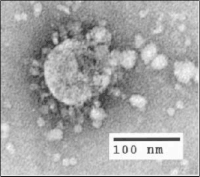
Photo from wikipedia
Here we report the isolation of the influenza A/H1N1 2009 pandemic (A/H1N1pdm) and A/H3N2 viruses carrying an I38T mutation in the polymerase acidic protein—a mutation that confers reduced susceptibility to… Click to show full abstract
Here we report the isolation of the influenza A/H1N1 2009 pandemic (A/H1N1pdm) and A/H3N2 viruses carrying an I38T mutation in the polymerase acidic protein—a mutation that confers reduced susceptibility to baloxavir marboxil—from patients before and after treatment with baloxavir marboxil in Japan. These variants showed replicative abilities and pathogenicity that is similar to those of wild-type isolates in hamsters; they also transmitted efficiently between ferrets by respiratory droplets. Resistance to baloxavir marboxil, a recently approved drug to treat influenza infection, was thought to make the virus less fit. This study reports that resistant viruses isolated from Japanese patients have normal replicative abilities and pathogenicity in animal models and thus might spread in humans.
Journal Title: Nature Microbiology
Year Published: 2019
Link to full text (if available)
Share on Social Media: Sign Up to like & get
recommendations!